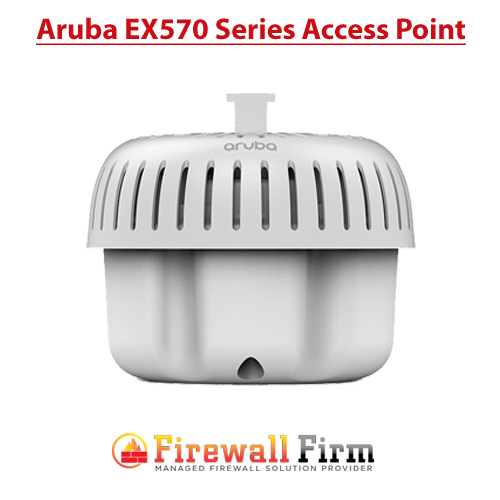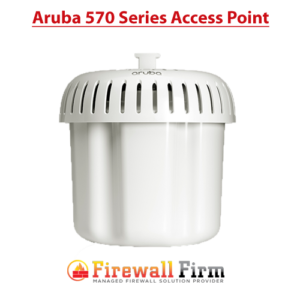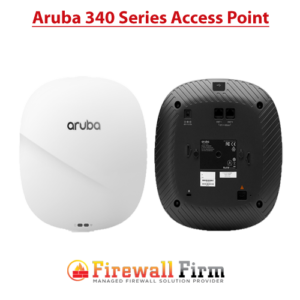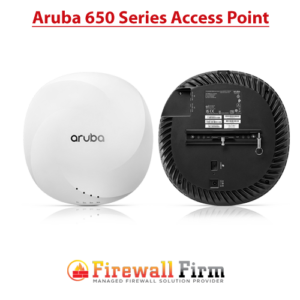Description
Aruba EX570 Series Access Point
Overview:
The Aruba EX570 series outdoor access points, with Wi-Fi 6 (802.11ax) technology, deliver the highest performance in outdoor and harsh weather environments such as parking lots, stadiums, and other public venues.
The EX570 series is purpose-built to withstand extreme high and low temperatures, persistent moisture and precipitation, and are fully sealed to keep out airborne contaminants.
Innovations include AI-powered RF optimization, Live upgrades, WPA3 and Enhanced Open certified security, and unified wired and wireless policy with Dynamic Segmentation.
Specifications:
| HARDWARE VARIANTS |
- AP-574
- 5 GHz: Four Nf connectors for external antenna operation
- 2.4 GHz: Two Nf connectors for external antenna operation
- BLE/Zigbee: Integrated omnidirectional antenna and peak gain of 4.2dBi
- AP-575
- Built in Omni Directional Antennas
- 5 GHz: Antennas 5 dBi
- 2.4 GHz: Antennas 3.4 dBi
- BLE/Zigbee: Integrated omnidirectional antenna and the peak gain of 6dBi
- AP-577
- Built in 90°H x 90°V Directional Antennas
- 5 GHz: Antennas 5.6 dBi
- 2.4 GHz: Antennas 6.8 dBi
- BLE/Zigbee: Integrated omnidirectional antennas with peak gain of 8.4dBi
|
| WI-FI RADIO SPECIFICATIONS |
- AP type:
- Outdoor Hardened, Wi-Fi 6 dual radio, 5 GHz 4×4 MIMO and 2.4 GHz 2×2 MIMO
- Software-configurable dual radio supports 5 GHz (Radio 0) and 2.4 GHz (Radio 1)
- 5GHz:
- Four spatial stream Single User (SU) MIMO for up to 4.8 Gbps wireless data rate to individual 4SS HE160 Wi-Fi 6 client device (max)
- Two spatial stream Single User (SU) MIMO for up to 1.2 Gbps wireless data rate to individual 2SS HE80 Wi-Fi 6 client device (typical)
- Four spatial stream Multi User (MU) MIMO for up to 4.8 Gbps wireless data rate to up to four 1SS or two 2SS HE160 Wi-Fi 6 DL-MU-MIMO capable client devices simultaneously (max)
- Four spatial stream Multi User (MU) MIMO for up to 2.4 Gbps wireless data rate to up to four 1SS or two 2SS HE80 Wi-Fi 6 DL-MU-MIMO capable client devices simultaneously (typical)
- 2.4GHz:
- Two spatial stream Single User (SU) MIMO for up to 575 Mbps wireless data rate to individual 2SS HE40 Wi-Fi 6 client device (max)
- Two spatial stream Single User (SU) MIMO for up to 287 Mbps wireless data rate to individual 2SS HE20 Wi-Fi 6 client device (typical)
- Two spatial stream Multi User (MU) MIMO for up to 575 Mbps wireless data rate to up to two 1SS HE40 Wi-Fi 6 DL- MU-MIMO capable client devices simultaneously (max)
- Two spatial stream Multi User (MU) MIMO for up to 287 Mbps wireless data rate to up to two 1SS HE20 Wi-Fi 6 DL- MU-MIMO capable client devices simultaneously (typical)
- Support for up to 512 associated client devices per radio, and up to 16 BSSIDs per radio
- Supported frequency bands (country-specific restrictions apply):
- 2.400 to 2.4835 GHz
- 5.150 to 5.250 GHz
- 5.250 to 5.350 GHz
- 5.470 to 5.725 GHz
- 5.725 to 5.850 GHz
- 5.825 to 5.875 GHz
- Available channels: Dependent on configured regulatory domain
- Dynamic frequency selection (DFS) optimizes the use of available RF spectrum.
- Supported radio technologies:
- 802.11b: Direct-sequence spread-spectrum (DSSS)
- 802.11a/g/n/ac: Orthogonal frequency-division multiplexing (OFDM)
- 802.11ax: Orthogonal frequency-division multiple access (OFDMA) with up to 16 resource units (RU)
- Supported modulation types:
- 802.11b: BPSK, QPSK, CCK
- 802.11a/g/n: BPSK, QPSK, 16-QAM, 64-QAM, 256-QAM (proprietary extension)
- 802.11ac: BPSK, QPSK, 16-QAM, 64-QAM, 256-QAM,1024-QAM (proprietary extension)
- 802.11ax: BPSK, QPSK, 16-QAM, 64-QAM, 256-QAM, 1024-QAM
- 802.11n high-throughput (HT) support: HT 20/40
- 802.11ac very high throughput (VHT) support: VHT 20/40/80/160
- 802.11ax high efficiency (HE) support: HE20/40/80/160
- Supported data rates (Mbps):
- 802.11b: 1, 2, 5.5, 11
- 802.11a/g: 6, 9, 12, 18, 24, 36, 48, 54
- 802.11n (2.4GHz): 6.5 to 300 (MCS0 to MCS15, HT20 to HT40)
- 802.11n (5GHz): 6.5 to 600 (MCS0 to MCS31, HT20 to HT40)
- 802.11ac: (5 GHz): 6.5 to 3,467 (MCS0 to MCS9, NSS = 1 to 4 for VHT20 to VHT160)
- 802.11ax (2.4GHz): 8.6 to 574 (MCS0 to MCS11, NSS = 1 to 2, HE20 to HE40)
- 802.11ax (5GHz): 8.6 to 4803 (MCS0 to MCS11, NSS = 1 to 4, HE20 to HE160)
- 802.11n/ac packet aggregation: A-MPDU, A-MSDU
- Transmit power: Configurable in increments of 0.5 dBm
- Maximum (conducted) transmit power (limited by local regulatory requirements):
- 2.4 GHz band: +22 dBm per chain , +25dBm aggregate (2×2)
- 5 GHz band: +22 dBm per chain , +28dBm aggregate (4×4)
- Note: conducted transmit power levels exclude antenna gain.
- Maximum EIRP (limited by local regulatory requirements):
- 2.4 GHz band:
- AP-574: 25 + Antenna Gain + TxBF Gain
- AP-575: 29.0 dBm EIRP
- AP-577: 34.4 dBm EIRP
- 5 GHz band:
- AP-574: 28 + Antenna Gain + TxBF Gain
- AP-575: 32.6 dBm EIRP
- AP-577: 36 dBm EIRP
- Advanced Cellular Coexistence (ACC) minimizes interference from cellular networks.
- Maximum ratio combining (MRC) for improved receiver performance.
- Cyclic delay/shift diversity (CDD/CSD) to enable the use of multiple transmit antennas.
- Short guard interval for 20-MHz, 40-MHz, 80-MHz and 160-MHz channels.
- Space-time block coding (STBC) for increased range and improved reception.
- Low-density parity check (LDPC) for high-efficiency error correction and increased throughput.
- Transmit beam-forming (TxBF) for increased signal reliability and range.
|
| ADDITIONAL INTERFACES |
- E0: HPE SmartRate port (RJ-45)
- Auto-sensing link speed (100/1000/2500BASE-T) and MDI/MDX
- 2.5Gbps speed complies with NBase-T and 802.3bz specifications
- PoE-PD: 48Vdc (nominal) 802.3at/bt (Class 4 or higher)
- 802.3az Energy Efficient Ethernet (EEE)
- E1: 10/100/1000BASE-T (RJ-45)
- Auto-sensing link speed and MDI/MDX
- 802.3az Energy Efficient Ethernet (EEE)
- PoE-PD: 48Vdc (nominal) 802.3at/bt (Class 4 or higher)
- Link Aggregation (LACP) support between both network ports for redundancy and increased capacity
- Bluetooth 5 and 802.15.4 radio
- 2.4 GHz
- Bluetooth 5: up to 8dBm transmit power and -95 dBm receive sensitivity
- Zigbee: up to 8 dBm transmit power and -97 dBm receive sensitivity
- Up to 4 dBm transmit power (class 2) and -91 dBm receive sensitivity
- Visual indicator (multi-color LED):
- For system and radio status
- Reset button:
- Factory reset (during device power up)
- USB-C console interface
|
| POWER |
- Maximum (worst-case) power consumption:
- PoE powered (dual ports): 32.0W
- PoE powered (single port, full function): 26.1W
- Maximum (worst-case) power consumption in idle mode:
- 14.0W (single PoE) or 16.0W (dual PoE)
- Maximum (worst-case) power consumption in deep-sleep mode:
- 2.9W (single PoE) or 3.9W (dual PoE)
- The AP supports Power over Ethernet (PoE) on port E0 and/or E1
- When PoE power is supplied to both Ethernet ports, the AP can be configured to combine or prioritize power sources
- Power sources are sold separately;
- When powered by 1x 802.3at (class 4) PoE and with the IPM feature disabled, the AP will disable the other Ethernet port. In the same configuration but with IPM enabled, the AP will start up in unrestricted mode, but may dynamically apply restrictions depending on the PoE budget and actual power. The feature restrictions and order can be programmed.
- Operating the AP with single or dual 802.3af (class 3 or lower) PoE source is not supported.
|
Security
- Integrated wireless intrusion protection offers threat protection and mitigation, and eliminates the need for separate RF sensors and security appliances
- IP reputation and security services identify, classify, and block malicious files, URLs and IPs, providing comprehensive protection against advanced online threats
- Integrated Trusted Platform Module (TPM) for secure storage of credentials and keys
Networking on a budget
With the integrated BLE and supporting 802.3af power, the Series APs enable enterprises to improve their work efficiency and productivity with the lowest TCO. When Ethernet drops are not available, VPN tunnels extend remote locations to corporate resources and wireless mesh connections.
Highly secure and reliable performance
The Series APs offer improved network simplicity and security in several ways. Dynamic Segmentation automatically enforces real-time, device-level access policies on Aruba wired and wireless networks. Additionally, Aruba AppRF technology leverages deep- packet inspection to classify and block, prioritize, or limit bandwidth for over 2,500 enterprise apps or groups of apps.
Flexible management options
Available management solutions include Aruba Central (available in cloud-managed and on-premises options), as well as Aruba AirWave, which supports multi-vendor networks. APs can be deployed with zero-touch provisioning to reduce deployment time, centralize configuration, and simplify inventory management.
Aruba Access Point
Buy Aruba Access Point online from Firewall Firm’s IT Monteur Store
Sales Number : +91 9582 90 7788
Support Number : +91-9654016484
Sales Email : sales@itmonteur.net
Support Email : support@itmonteur.net
 Firewall Training in India Cyber Security Training & Firewall Training Provider in India
Firewall Training in India Cyber Security Training & Firewall Training Provider in India















